|
Just
about any photo of a soldier battling his enemy or environment will be both revealing
and inspiring to modelers who like to add figures to their AFVs and dioramas.
These books are my favorite sources for determining the timing of uniform and
equipment changes, colors, uses, etc.
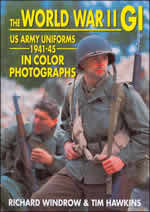 The
World War II GI: US Army Uniforms 1941-45 in Color Photographs, by Richard
Windrow and Tim Hawkins, Motorbooks International, 1993, ISBN 0-87938-832-3. ($40) The
World War II GI: US Army Uniforms 1941-45 in Color Photographs, by Richard
Windrow and Tim Hawkins, Motorbooks International, 1993, ISBN 0-87938-832-3. ($40)
Until the following
book came out, this was the best, most comprehensive book on topic, with scores
of contemporary photos of actual wartime issue uniforms, gear and weapons. It
covers infantry, airborne and armored troops. If you want to populate your AFVs
and dioramas with figures, this is definitely and the one below are the first
two books you should invest in. Richard
Windrow is a noted modeler and author of Terrain Modeling Masterclass,
published by Osprey.
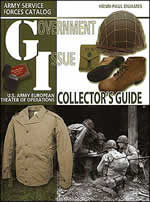 Government
Issue Collector's Guide: Army Service Forces Catalog, U.S. Army European Theater
of Operations, by Henri-Paul Enjames, Histoire & Collections, 2003,
ISBN 2-913903-87-8. ($45) Government
Issue Collector's Guide: Army Service Forces Catalog, U.S. Army European Theater
of Operations, by Henri-Paul Enjames, Histoire & Collections, 2003,
ISBN 2-913903-87-8. ($45)
Following
the format of the 1943 Quartermasters Corps supply catalog, this book is an astounding
compilation of U.S. WWII militaria. It includes insignia, uniforms, personal equipment,
weapons, tents and bivouac gear for regular infantry, as well as items used by
armored troops, paratroopers, military police, medics, signal corps, chaplains,
etc. The items come from the personal collections of the author and other collectors
as well as museums. They are photographed in color, augmented by a small number
of black and white period photos from technical manuals. The book runs nearly
300 pages and each one is a gold mine for diorama builders, especially those who
want to scratchbuild items like cook stoves, airborne handcarts, or carrier pigeon
box. The Windrow and Hawkins book has an advantage in seeing the uniforms and
gear worn and used by reenactors, but this is much more comprehensive. 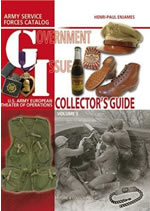 Government
Issue: US Army European Theater of Operations Collectors Guide, Volume II,
by Henri-Paul Enjames, Histoire & Collections, 2008, ISBN: 978-2-35250-079-7. Government
Issue: US Army European Theater of Operations Collectors Guide, Volume II,
by Henri-Paul Enjames, Histoire & Collections, 2008, ISBN: 978-2-35250-079-7.
Says
Rod Crisman, "Don't get me wrong, the book is useful, to an extent. It does
contain a nice order of battle for infantry, armored and airborne divisions. But,
beyond that, it goes into areas that most, if any, of us modelers would seldom
need or have an interest in. It was said that after the first volume was published,
that many collectors and even veterans, sent mail discussing what wasn't
in the book, hence Volume 2, said to contain everything that not included in the
first. Well, there's a reason for that. It's not that interesting!" [read
more]
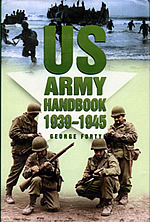 The
US Army Handbook 1941-1945, by George Forty, Barnes & Noble Books,
1998, ISBN 0-7607-0848-7. ($10) The
US Army Handbook 1941-1945, by George Forty, Barnes & Noble Books,
1998, ISBN 0-7607-0848-7. ($10)
This
book will give you all the basics on the US Army of the era, including:
- Army and Airborne
divisional units and strengths down to platoon level
- Uniforms
and equipment
- Weapons
- Vehicles
and Markings
There
are plenty of historical black and white photos. The book does not offer a great
deal of depth on these topics, but will answer most of the general questions you
might have. And for $10 at Barnes & Noble it’s a steal. 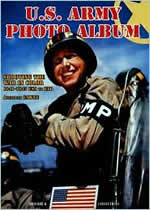 Shooting
the War in Color, 1941-1945 USA to ETO, by Jonathan Gawne, Histoire &
Collections, 1996, ISBN 2-908-182-40-8. ($40) Shooting
the War in Color, 1941-1945 USA to ETO, by Jonathan Gawne, Histoire &
Collections, 1996, ISBN 2-908-182-40-8. ($40)
This
is a compilation of historical color photos including stateside training and locations
in the Mediterranean, the UK, Normandy, Southern France, and through Europe into
Germany. Good photos of soldiers, vehicles and artillery. Use caution when relying
on them as examples of “true” colors of paints and fabrics, however.
Not only did colors of materials fade from wear and weather, color film dyes can
shift over time, and not all color printing processes for books are exact. 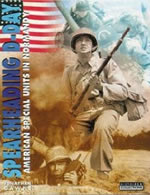 Spearheading
D-Day: American Special Units of the Normandy Invasion, by Jonathan Gawne,
Histoire & Collections, 1998, ISBN 2-908-182-793. ($40) Spearheading
D-Day: American Special Units of the Normandy Invasion, by Jonathan Gawne,
Histoire & Collections, 1998, ISBN 2-908-182-793. ($40)
This is undoubtedly
the definitive photographic record of the myriad US groups involved in the invasion
of the Normandy beaches (airborne units are not covered). Landing crafts, assault
units, demolition teams, regimental combat units, Rangers, Naval Beach Battalions,
engineering units and post-invasion support are covered here in revealing detail.
Uniforms typical for many organizations are modeled in color photos. This book
is a must-have for anyone interested in modeling — or just learning more
about — this pivotal event. Patton's
Third Army, GI Series: The Illustrated History of the American Soldier, His Uniform
and His Equipment, by Christopher J. Anderson, Stackpole
Books/Greenhill Books, 1997, ISBN 1-85367-290-4. ($14) The
Fall of Fortress Europe from the Battle of the Bulge to the Crossing of the Rhine,
GI Series: The Illustrated History of the American Soldier, His Uniform and His
Equipment, by Christopher J. Anderson, Stackpole Books/Greenhill Books,
1997, ISBN 1-85367-290-4. ($14) These
two books by Christopher Anderson are similar in format, with a brief narrative
of the war and changes in uniforms and equipment during that time. The following
65 pages include a few pages of color photos and a lot of black and white shots
of soldiers at work and rest. The captions are very helfpul in identifying clothing
and gear. 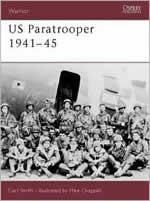 U.S.
Paratrooper 1941-45, by Carl Smith, illustrated
by Mike Chappell, Osprey Publishing, 2000, ISBN 1-84176-258-X. ($17) U.S.
Paratrooper 1941-45, by Carl Smith, illustrated
by Mike Chappell, Osprey Publishing, 2000, ISBN 1-84176-258-X. ($17)
If you're just
getting into building paratrooper figures, this book is a good starting point
to understand the unique uniforms and equipment used by these truly special forces.
Following the typical Osprey format (this was previously published under the same
title as #26 in the Warrior series), the book provides basic nuggets of information.
About half the book covers the formation of the airborne divisions and basic training,
and the rest of the book deals with their combat roll. While lacking the vigorof
Ron Volstad's work, the color plates by Mike Chappell are nicely illustrated and
will be a good guide for getting to know the paratrooper's equipment and working
out painting details. One big revelation this book provided: airborne glider troops
wore the same uniforms and used the same equipment as infantry. The only distinguishing
feature that identified them as airborne was their shoulder insignia! That opens
up larger possibilities for figure choices in your dioramas once you determine
where glider troops and paratroopers fought as integral units. 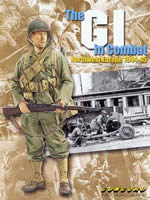 The
GI in Combat, Northwest Europe 1944-45, by Steven
J. Zaloga, illustrated by Ronald Volstad, Concord Publications, 2002, ISBN 962-361-690-2.
($15) The
GI in Combat, Northwest Europe 1944-45, by Steven
J. Zaloga, illustrated by Ronald Volstad, Concord Publications, 2002, ISBN 962-361-690-2.
($15)
This
is a must-have source of inspiration for anyone who enjoys building U.S. figures
and dioramas. While a slim 52 pages, this book is chock full of excellent photos,
many never before seen, of American soldiers in all sorts of activities "over
there." Most notable are the half dozen photos of 2nd Armored Division soldiers
in the ill-fated camo uniforms that were soon discarded after too many soldiers
were mistaken as German SS. There are also good shots of men equipped with .30
and .50 machine guns, bazookas, mortars, and artillery pieces. There are four
color plates from Ron Volstad, including box art from the DML tank crew and Bastogne
airborne sets, and two that may be from DML's action figure line. They serve as
good uniform and painting guides. Highly recommended! Comments
by Tim Streeter (unless otherwise noted) |













 The
World War II GI: US Army Uniforms 1941-45 in Color Photographs, by Richard
Windrow and Tim Hawkins, Motorbooks International, 1993, ISBN 0-87938-832-3. ($40)
The
World War II GI: US Army Uniforms 1941-45 in Color Photographs, by Richard
Windrow and Tim Hawkins, Motorbooks International, 1993, ISBN 0-87938-832-3. ($40) Government
Government Government
Issue: US Army European Theater of Operations Collectors Guide, Volume II,
by Henri-Paul Enjames, Histoire & Collections, 2008, ISBN: 978-2-35250-079-7.
Government
Issue: US Army European Theater of Operations Collectors Guide, Volume II,
by Henri-Paul Enjames, Histoire & Collections, 2008, ISBN: 978-2-35250-079-7.
 The
US Army Handbook 1941-1945, by George Forty, Barnes & Noble Books,
1998, ISBN 0-7607-0848-7. ($10)
The
US Army Handbook 1941-1945, by George Forty, Barnes & Noble Books,
1998, ISBN 0-7607-0848-7. ($10) Shooting
the War in Color, 1941-1945 USA to ETO, by Jonathan Gawne, Histoire &
Collections, 1996, ISBN 2-908-182-40-8. ($40)
Shooting
the War in Color, 1941-1945 USA to ETO, by Jonathan Gawne, Histoire &
Collections, 1996, ISBN 2-908-182-40-8. ($40) Spearheading
D-Day: American Special Units of the Normandy Invasion, by Jonathan Gawne,
Histoire & Collections, 1998, ISBN 2-908-182-793. ($40)
Spearheading
D-Day: American Special Units of the Normandy Invasion, by Jonathan Gawne,
Histoire & Collections, 1998, ISBN 2-908-182-793. ($40)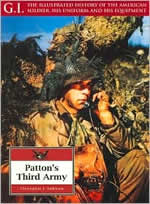
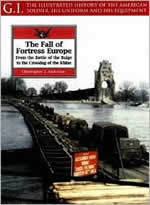
 U.S.
Paratrooper
U.S.
Paratrooper The
GI
The
GI